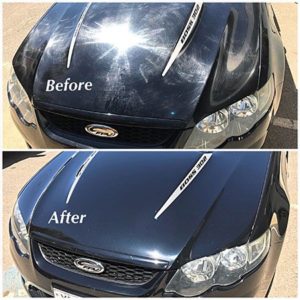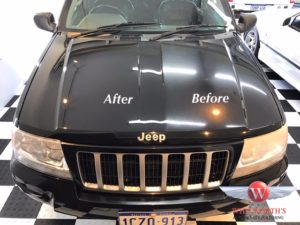
What are the benefits of car polishing?
There are many benefits of car polishing.
This includes:
- Removing fine or heavy scratches or defects
- Decontamination of the paintwork that a bucket and sponge can’t remove
- Paint correction
- Restoration of paint fading
- Adding gloss and shine to the paintwork
- Colour depth enhanced and colour rejuvenation
The sad reality of life is few of us have time to wash our cars every month, let alone give them a good cut and polish. When you’re out on the road driving there are many elements that are compromising your paint.
To begin with the harsh Australian sun. This can cause paint fading. Fading is very prominent in our harsh, hot climate.
Road contamination. Road tar, dirt, grease and other grit embeds into the paint when we drive around. Microscopic metal dust from railway lines and construction sites are also a common issue. If left untreated this will rust on the paintwork and can lead to serious corrosion.
Nature. Bird droppings, suicidal bugs (or whole families of bugs) seem to make their deadly end all over your paintwork. The acidity in these bugs and droppings eats through paint. Fast. Same goes with irrigation water. The water evaporates from your car leaving the mineral deposits behind which can “etch” into the paint. It is highly recommended to have your car paint protected to avoid any lasting damage.
All these things layer onto your paint. If you wash your car regularly (like once every 2-3 weeks) then most of this can be removed. But not all of it can be removed with a bucket and sponge and over time it builds up on the paint. If you wash your car and then run the back of your hand over the paintwork you can feel that build up. It will feel ever so slightly rough. Even a brand new car will have contaminants from the factory, the shipping and from the environment of the storage facility. It’s much like plaque on your teeth. Even though you brush your teeth twice a day they still need to be professionally cleaned to remove stubborn build up.
This build up is not deadly to the paint and only a natural part of driving around. Nevertheless, a professional should remove it every 12 months.

When a professional car polisher services your car, they just remove that level of build up – and NOT any of the paint itself. The build-up for most new/used car is layered on top of the clear coat/paint. However, for some classic and commercial cars there isn’t any clear coat on the car, so what do you do then? You have to use the tools of the trade, like a micrometer (paint thickness measuring device). This is so you know how much paint you can take off without burning through to the steel – scary stuff. Especially if you don’t know what you are doing.
Car polishing has been around for decades. The unfortunate fact is there isn’t many professionals out there that know what they are doing. Sure, if you are giving the car a light hand polish most of the time not too much can go wrong. However, the paint can be compromised as soon as you start using a machine.

So what’s the difference between a novice car polisher and a professional?
Assessment of paint condition. A professional will be able to look at your car and tell which level of car polishing or paint correction is required.
Tools of the trade. A professional should know which type of polishing compound to use, and which polishing pad is the best for this car. They will know the pressure to apply the polishing machine on the car without burning through the paint. They will also have tools to help them. Such as a micrometer and sufficient lighting such as our polishing studio.
Professionals are professionally trained and have years of experience. They know the difference between new and old car paint types. Even different types of cars have different types of clear coat. Hard clear coat will take a heavier compound and pad and so it will take longer to polish. Softer clear coat is also difficult to polish. It’s easier to damage, create swirls in the finish and can scratch very easily.
Novice and self-taught car polishers are sadly everywhere. Even car dealers and panel beaters create terrible results. They can cause irreversible damage to your cars paintwork. Such as buffing trails (hazy polishing swirls), micro scratching from improper use of compounds and pads. Not to mention accidentally burning through paintwork. his is mainly because of inexperience. Below is an example of a repair job we did on botched polishing work. You can see the heavy polishing marks on the paint. Luckily, it was repairable and not requiring a respray.

What is the difference between car polishing and paint correction?
Well paint correction is just as it sounds. It’s restoring the cars paintwork to remove defects and bring back the original lustre and shine, to make it brand new again. Car polishing can mean the same thing but there are different levels of car polishing to correct paintwork. This will depend on how light or heavy duty you need the polishing to go. We talk about different levels of car polishing below. If your car is in good condition, chances are you will just need to restore the shine with a good single stage polish. But if you have a car that has scratches, swirls or paint fade you will need to go for a two stage or more commonly referred to as a cut and polish. This means you are cutting through the scratches, into the clear coat to smooth everything out. And then polishing it to a mirror shine. The smoother the paint, the shiner it is. A professional should know the safe levels of clear coat to remove. Without compromising the paint health underneath.

What are the levels of car polishing?
Generally speaking there is three stages of car polishing. Light, medium and heavy. Depending on what your car needs. We will explain below, what each stage means, and what we offer at Whitworth’s.
The first level (light) is our Shine-Up Polish service. This is our single-stage car polishing service and is more of a maintenance service to keep your car staying clean and shiny. This includes light paint decontamination with a clay bar machine, we can remove a handful of scratches and the single stage polish brings the shine back to your car. The work is then finished by a glaze protecting sealant and you are ready to go.
The second level (medium) is a Two-Stage Paint Correction and is our most popular. This is when you have swirls in the paintwork or light scratches. Swirls can be caused by micro-scratching when you wash your car. Even the clean cloth itself can be scratching the cars paint. As clear coat can be softer on some cars than others.Unlike the shine-up polish, we also more heavily decontaminate the paint using special chemicals. These chemicals eat through the road grime, dirt and grease. All without harming the paint work. These special chemicals are kinda cool. You can actually see the grime melting off the paintwork to reveal a nice clean panel. This decontamination resets the paint back to a nice clean surface. We can then begin polishing. We polish your car twice. Hence being called a ‘two stage’ paint correction. The first stage of polishing is using a heavy polishing compound with a heavy pad to remove any scratches or defects in the paint work. This will remove fine scratches or swirls but will also lightly mar the paint. Your car is then polished a second time with a lighter compound to refine the finish creating a swirl free super-sheen glossy paint. As you have just polished off any other waxes that would be previously protecting the cars paintwork, the car should always be finally sealed with a paint protection.
The third level (heavy) is a Three-Stage Paint Correction. This is when you have heavy defects such as 4WD bush scratches. We essentially do everything the same as the Two-Stage service however it takes far longer to restore the paintwork due to having to use sandpaper and performing more polishing stages with alternative compounds and pads. As well as techniques specific to the damage on your cars paintwork. We also regularly measure your cars paint thickness. This is important when going to this level of paint correction. The last thing you want is to burn through the paint because you are going too rough. This is when it’s super important to hire someone you trust. If this level of polishing is done incorrectly then sadly the only option could be to respray the entire car. A respray would cost thousands. That said, get the right person (like us!) to do it for you and you can save yourselves thousands by not needing a respray. We have had many customers come to us thinking the only option is respray and we have brought the whole car back to life. Our countless five star reviews are from many, many happy customers when just this has happened.

Therefore, in conclusion, the benefits of polishing your car are many and varied depending on what your car needs. Such as reducing scratches, reviving paintwork, restore fading, removing road contamination, paint correction and your annual paint protection maintenance. There are also three levels of car polishing. Light polishing to remove light contamination and bring back shine. A medium cut and polish to reduce scratches or swirls. And a heavy paint correction to target heavy bush scratches and serious contaminants.
If you are interested in any of our car polishing services please give our Master Polisher, Lee Whitworth, a call today on 0404 010 956.

